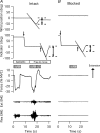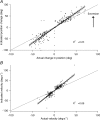Illusory movements of a phantom hand grade with the duration and magnitude of motor commands
- PMID: 20194129
- PMCID: PMC2872732
- DOI: 10.1113/jphysiol.2009.183038
Illusory movements of a phantom hand grade with the duration and magnitude of motor commands
Abstract
The senses of limb movement and position are critical for accurate control of movement. Recent studies show that central signals of motor command contribute to the sense of limb position but it is not clear whether such signals influence the distinctly different sense of limb movement. Nine subjects participated in two experiments in which we inflated a cuff around their upper arm to produce an ischaemic block, paralysing and anaesthetising the forearm, wrist and hand. This produces an experimental phantom wrist and hand. With their arm hidden from view subjects were asked to make voluntary efforts with their blocked wrist. In the first experiment, efforts were 20 and 40% of maximum and were 2 and 4 s in duration. The second experiment used 1 and 5 s efforts of 5 and 50% of maximum. Subjects signalled perceived movements of their phantom wrist using a pointer. All subjects reported clear perceptions of movement of their phantom hand for all levels and durations of effort. On average, subjects perceived their phantom wrist to move between 16.4 +/- 3.3 deg (mean +/- 95% confidence interval (CI)) and 30.2 +/- 5.4 deg in the first experiment and between 10.3 +/- 3.5 and 38.6 +/- 6.7 deg in the second. The velocity of the movements and total displacement of the phantom graded with the level of effort, and the total displacement also graded with duration. Hence, we have shown that motor command signals have a novel proprioceptive role in the perception of movement of human joints.
Figures







Similar articles
-
Phantom hand and wrist movements in upper limb amputees are slow but naturally controlled movements.Neuroscience. 2016 Jan 15;312:48-57. doi: 10.1016/j.neuroscience.2015.11.007. Epub 2015 Nov 10. Neuroscience. 2016. PMID: 26556065
-
Signals of motor command bias joint position sense in the presence of feedback from proprioceptors.J Appl Physiol (1985). 2009 Mar;106(3):950-8. doi: 10.1152/japplphysiol.91365.2008. Epub 2008 Dec 31. J Appl Physiol (1985). 2009. PMID: 19118155
-
Motor control over the phantom limb in above-elbow amputees and its relationship with phantom limb pain.Neuroscience. 2009 Aug 4;162(1):78-86. doi: 10.1016/j.neuroscience.2009.04.061. Epub 2009 May 3. Neuroscience. 2009. PMID: 19406214
-
Illusory limb movements activate different brain networks than imposed limb movements: an ALE meta-analysis.Brain Imaging Behav. 2018 Aug;12(4):919-930. doi: 10.1007/s11682-017-9756-1. Brain Imaging Behav. 2018. PMID: 28801769
-
And Yet It Moves: What We Currently Know about Phantom Arm Movements.Neuroscientist. 2020 Aug;26(4):328-342. doi: 10.1177/1073858420904326. Epub 2020 Feb 28. Neuroscientist. 2020. PMID: 32111136 Review.
Cited by
-
Effort matching between arms depends on relative limb geometry and personal control.J Neurophysiol. 2019 Feb 1;121(2):459-470. doi: 10.1152/jn.00346.2018. Epub 2018 Dec 12. J Neurophysiol. 2019. PMID: 30540499 Free PMC article.
-
Dynamic changes in the perceived posture of the hand during ischaemic anaesthesia of the arm.J Physiol. 2011 Dec 1;589(Pt 23):5775-84. doi: 10.1113/jphysiol.2011.219949. Epub 2011 Sep 26. J Physiol. 2011. PMID: 21946853 Free PMC article. Clinical Trial.
-
A novel path to chronic proprioceptive disability with oxaliplatin: Distortion of sensory encoding.Neurobiol Dis. 2016 Nov;95:54-65. doi: 10.1016/j.nbd.2016.07.004. Epub 2016 Jul 7. Neurobiol Dis. 2016. PMID: 27397106 Free PMC article.
-
Presbypropria: the effects of physiological ageing on proprioceptive control.Age (Dordr). 2012 Oct;34(5):1179-94. doi: 10.1007/s11357-011-9300-y. Epub 2011 Aug 18. Age (Dordr). 2012. PMID: 21850402 Free PMC article.
-
Anaesthesia changes perceived finger width but not finger length.Exp Brain Res. 2015 Jun;233(6):1761-71. doi: 10.1007/s00221-015-4249-1. Epub 2015 Mar 19. Exp Brain Res. 2015. PMID: 25788010
References
-
- Allen TJ, Proske U. Effect of muscle fatigue on the sense of limb position and movement. Exp Brain Res. 2006;170:30–38. - PubMed
-
- Gandevia SC. Roles for perceived voluntary motor commands in motor control. Trends Neurosci. 1987;10:81–85.
Publication types
MeSH terms
LinkOut - more resources
Full Text Sources

